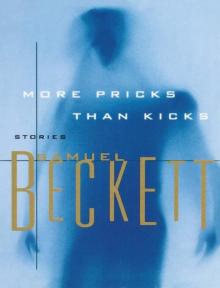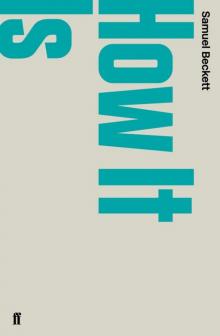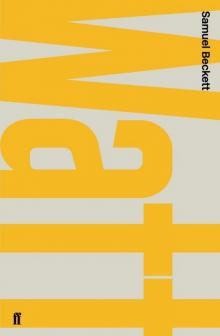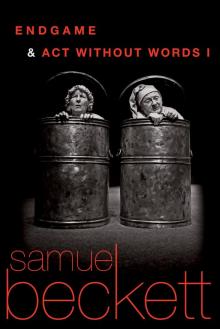- Home
- Samuel Beckett
Texts for Nothing and Other Shorter Prose 1950-1976 Page 2
Texts for Nothing and Other Shorter Prose 1950-1976 Read online
Page 2
The Lost Ones
Beckett started a new work, eventually called Le Dépeupleur, in October 1965, but after a struggle abandoned it in May 1966. Le Dépeupleur would, in turn, generate a host of other texts. However, in a letter dated 21 March 1970, Beckett told Calder that he was now considering publishing the unfinished work in its entirety. Le Dépeupleur duly appeared from Les Éditions de Minuit in 1970, and Beckett added a concluding paragraph shortly before correcting proofs in May 1970. He translated it into English between September and November 1971, and The Lost Ones was published by Calder and then Grove Press in 1972 (the latter photoset from the former).15 The narrative describes a cylinder containing roughly 200 ‘little people’, all seeking their lost ones, or seeking an exit. The scrutiny of the space itself, as well as the rules and behaviour governing its inhabitants, is scientific in procedure and impersonal in tone, and further explores the closed spaces of All Strange Away and Imagination Dead Imagine.
Ping
The compositional history of the French text Bing (translated as Ping) is complex. There are ten surviving versions (held in manuscript notebooks and typescripts at Washington University, St Louis), which reveal just how much Beckett struggled to make progress with this text. Indeed, in a note accompanying the manuscripts, Beckett specified that ‘Bing may be regarded as the result or miniaturization of Le Dépeupleur abandoned because of its intractable complexities.’ Having abandoned this longer text, Beckett salvaged parts in a new composition on 20 June 1966 with the title ‘Blanc’, which he finished by September 1966 and which was published the following month as Bing in a limited edition by Les Éditions de Minuit. The English translation was begun immediately thereafter, and Ping was first published in the magazine Encounter (February 1967). It was not the only text to come out of the abandoned French piece Le Dépeupleur, as Beckett subsequently allowed four extracts (or rather ‘rejected texts’) to be published in small magazines and art editions.16
Although Beckett stated that Bing was of the ‘same future’ as Imagination Dead Imagine, he was equally at pains to stress the fact that they are very different. Indeed, the text is closely linked to the failed project from which it arose, Le Dépeupleur. His sense of relief at having been able to keep alive at least part of this larger text is evident in his admission, in a letter to Jocelyn Herbert, that Ping was ‘hardly publishable which matters not at all’. Indeed, one can only suspect that the kind of writing produced by this ‘miniaturization’ was precisely what Beckett was striving for, ‘brief and outrageous all whiteness and silence and finishedness’.17 Outrageous, yes, in that Beckett fashions a new linguistic minimalism in this text, forgoing verbs, articles, pronouns and prepositions, as well as punctuation other than the full stop, while giving rein to verbal echoes, eye rhymes and repetitions made musical through assonance and alliteration.
Lessness
Beckett was to use the mathematical dimensions of the ‘closed space texts’ in the compositional process of Sans, finished in August 1969 and published that same year by Les Éditions de Minuit. A set of six thematic groups (‘families’) of ten sentences are arranged in different permutations and combinations.18 According to Beckett’s foreword to the Calder edition (Signature Series 9, 1970), the work deals with the ‘collapse of some such refuge as that last attempted in Ping and with the ensuing situation of the refugee’. Originally entitled ‘Without’, the English translation was first published as Lessness in the New Statesman on 1 May 1970. Sending the text to Calder at the end of March 1970, Beckett ironically referred to it as ‘Endless’, while drawing his publisher’s attention to the importance of being able to see proofs. Beckett made changes to the typographical structure of the text, in proof, first introducing paragraph breaks, before settling for paragraph indentation rather than breaks.
Beckett would continue to write, as he told Kay Boyle, in the same ‘scape’ as Lessness, albeit with dust rather than sand as the organic matter of choice.19 The result was ‘Pour finir encore’, which became one of the Foirades/Fizzles.
Fizzles
Originally written in French, five of these texts (‘He is barehead’, ‘Horn came always’, ‘I gave up before birth’, ‘Old earth’ and ‘Afar a bird’) were published individually in the journal Minuit between November 1972 and May 1973, before being collected by Les Éditions de Minuit as part of Pour finir encore et autre foirades in 1976. Their composition has often been dated to circa 1960, following Beckett’s own note to this effect to Calder.20 However, there is evidence to suggest that they were written in 1954.21 It is a sign of Beckett’s dissatisfaction that it took nearly twenty years for them to appear in print. Their publication in English was accelerated by the prospect of a limited edition illustrated by the American artist Jasper Johns. Beckett translated them between November 1973 and March 1975, replacing ‘Afar a bird’ with the more recent ‘Closed place’ (written 1968). The Jasper Johns edition, published in 1976, undoubtedly galvanised Beckett’s trade publishers into requesting their own respective editions of these shorts, so that in that same year Foirades was published by Les Éditions de Minuit, and Fizzles by both Calder and Grove Press. Together with ‘Closed place’, Beckett decided to add two further recent prose texts (‘Still’ and ‘For to End Yet Again’) to the original five. It is striking that all four editions present the texts in a different order, with Calder following Beckett’s own instructions of putting the most recent (and longest) text first, whereas Les Éditions de Minuit roughly followed the order of composition. ‘Closed place’ originated in French as ‘Se voir’ in 1968, and revisits the confined spaces of The Lost Ones and Bing. Often cited as ‘Endroit clos’ (the piece’s opening words), Beckett translated it as ‘Closed place’ in February 1974.22 His difficulties with the composition are evident from the five separate openings of the piece contained in a manuscript notebook entitled ‘Fragments Prose début 68’.23
Beckett began work on what was to become ‘Pour finir encore’ in November 1969, and appears to have finished it by October 1973.24 Beckett allowed an extract comprising a version of the opening seven sentences, aptly entitled ‘Abandonné’, to be published in a limited edition with illustrations by Geneviève Asse in 1972. He translated the story into English in December 1975, and the text first appeared in New Writing and Writers 13 (Calder, 1975) before becoming part of the French and English Foirades/Fizzles.25 The text plays on the familiar Beckettian distinctions of beginning and ending, but the incessant repetition and intractable difficulties produced by the lack of punctuation and unfamiliar syntactical arrangement of words render any summary incomplete.
Beckett wrote the final Fizzle, ‘Still’, in English in the months of June and July 1972 (before finishing ‘Pour finir encore’). It was first published in 1974 in a limited edition illustrated by Bill Hayter. It appears, from a letter to Ruby Cohn of September 1972, that Beckett envisaged a series of texts in the same vein as ‘Still’. Indeed, he proceeded to write two further related texts, which are given here in an appendix: ‘Sounds’ (first mentioned in September 1972, and finished in June 1973) and ‘Still 3’, which was written in June 1973. Both were first published in Essays in Criticism (April 1978), with an explanatory essay by John Pilling, who had convinced Beckett to allow them to be printed. One textual change has been made for the current edition: in ‘Still 3’, ‘lips the ones’ has been changed to ‘lids the ones’.26 No further ‘Still’ texts were written.
It appears that Beckett had as early as 1972 or 1973 begun to think of the first five of these texts as ‘Foirades’, citing in a letter to John Kobler of March 1973 an entry from his Petit Robert dictionary: ‘Foirade – Le fait de foirer. Foirer – rater, échouer lamentablement.’ As with From an Abandoned Work, Beckett’s sense of these texts as ‘failures’ is inscribed in their overall title. Alternately, he at times referred to the fact that ‘foirer’ related to diarrhoea, and the English title appears to have appealed to him for its connection with the action of breaking wind.27 It
is impossible to tell whether Beckett initially thought of ‘Still’ and ‘For to End Yet Again’ as ‘Foirades’, although the fact that in correspondence with Ruby Cohn he spoke of a ‘Still’ series suggests that this was not the case. If ‘Still’ is the odd text out here owing to its being the only piece written in English, ‘For to End Yet Again’ differs thematically and in terms of length from the other texts. There is a sense that the unity of the Foirades/Fizzles editions stems as much from the fact that these eight texts had not yet been collected in print as from any unifying stylistic or thematic coherence, although they share an increasing linguistic experimentation.28
As the Story Was Told
Beckett wrote As the Story Was Told (in English) quickly, between 4 and 13 August 1973. It was composed for a memorial volume of the German poet and writer Günter Eich, whom Beckett had met several times and who had committed suicide at the age of sixty-six.29 The story revolves around notions of guilt and punishment as a speaker endeavours to comprehend his part in the interrogation and torture of a man who is being held in a tent nearby. Although the piece is written with ostensible simplicity, it withholds the precise nature of the crime of the first-person narrator, or of the person under scrutiny. It was published in Günter Eich zum Gedächtnis (1973), then in Calder 1984.
La Falaise/The Cliff
Beckett’s next prose work was also dedicated to a fellow artist. Written in French between 6 January and 26 March 1975 with the working titles ‘Pour Bram’ or ‘À Bram’, in homage to Beckett’s friend, the painter Bram Van Velde, it was first published as ‘La Falaise’ in Celui qui ne peut se servir de mots: à Bram Van Velde (Fata Morgana, 1975), and remained untranslated by Beckett. The present edition reprints Edith Fournier’s translation first published in Grove 1995, and, because not translated by Beckett himself, the French original. Beckett told John Pilling in a postcard dated 7 October 1978 that he was not thinking of any specific painting by Van Velde when writing the text.30 As with so many of Beckett’s later works, La Falaise/The Cliff defies generic definition. Although its typographical layout marks this piece as prose, its tightly knit structure suggests a prose poem. Generic uncertainty is more evident still in the final work included in this edition, the very brief text neither.
neither
In his responses to the ‘queries re prelims to Collected Shorter Prose 1945–80’ (sent to Susan Herbert at Calder Publishers and dated 5 February 1984), Beckett stated that ‘neither’ was not written as a poem and that Calder could include the text in the prose volume should he wish, as long as he appended the note ‘Written for the composer Morton Feldman’. Beckett had previously opposed its inclusion in Collected Poems in English and French (Calder, 1977). Written in September 1976, neither was first published in the programme notes accompanying its performance in Rome on 12 June 1977, set to music by Feldman. The publication history is one of error, mainly of a typographical nature, based on a confusion as to whether to present the text as prose or verse. neither was reprinted, with errors, in the Journal of Beckett Studies 4 (1979) and gathered in As the Story Was Told: Uncollected and Late Prose (Calder, 1990). The work stresses inbetweenness, or rather a ‘between-ness’ moving ‘to and fro’ from inner to outer shadow, from self to unself, between poem and prose. The text is here presented without line breaks, according to Beckett’s wish that it be regarded as prose.
*
A short preface cannot do justice to the beauty and innovation of Beckett’s achievement in the short prose works collected in this volume. The reader will undoubtedly struggle at times with the mathematical, impersonal, uncertain spaces and spare language constructed by Beckett in the years 1950 to 1976. In the ‘closed spaces’ of Beckett’s imaging of consciousness, we are forced to move through stark and harsh landscapes. At the same time, presenting human existence in isolation, these works inscribe the immense poetic force of endurance and of a prose without adornment. In these twenty years of compositional struggle, Beckett paved the way for the luminous works of his final decade of writing – Company, Ill Seen Ill Said, Worstward Ho, Stirrings Still and his last text, ‘What is the word’. In removing all that is incidental, in textual and existential terms, Beckett can in these pages be seen slowly to write himself ever closer to what he called ‘the next next to nothing’.31
Excerpts from Samuel Beckett’s letters to Mary Hutchinson, John Fletcher, Kay Boyle, John Kobler, A. J. Leventhal, Ruby Cohn © The Estate of Samuel Beckett. Reproduced by kind permission of the Estate of Samuel Beckett c/o Rosica Colin Limited, London. Unpublished letters from Samuel Beckett to Mary Hutchinson, John Fletcher, Kay Boyle, John Kobler and A. J. Leventhal reproduced with kind permission of the Harry Ransom Humanities Research Center, The University of Texas at Austin. Unpublished letters from Samuel Beckett to Ruby Cohn reproduced with kind permission of the Beckett International Foundation, The University of Reading.
Notes
1 Letter to Mary Hutchinson, 6 February 1959, Harry Ransom Humanities Research Center, The University of Texas at Austin.
2 In a letter of 3 November 1965, Calder tells Beckett that he is being ‘pursued’ by readers who believe his publishing house has a ‘conspiracy’ to withhold Beckett’s short prose from publication. Beckett–Calder Correspondence, Beckett International Foundation, University of Reading, UoR MS2073/1.
3 Letter to John Fletcher, 20 May 1972, Harry Ransom Humanities Research Center, The University of Texas at Austin.
4 In establishing the order of composition followed in this volume, I am indebted to Emeritus Professor John Pilling.
5 John Calder, letter to Samuel Beckett, 30 October 1964, Beckett International Foundation, University of Reading, UoR MS2073/1.
6 Several of the Textes pour rien were first published in journals before being collectively published as Nouvelles et Textes pour rien by Les Éditions de Minuit in November 1955. See the publication list at the end of this volume for details.
7 Note, however, that XIII ‘Text for Nothing was written prior to XII’, but their order reversed by Beckett when published.
8 To give one example: there is a discrepancy in the hyphenation, or lack thereof, of ‘third class’ in ‘Text for Nothing VII’ across all editions, and Beckett himself appears to have been unsure about this. He thus in the typescript adds a hyphen to ‘third-class waiting-room’ but not to ‘third class ticket’, and then is not consistent in the proofs of subsequent editions. The present edition consistently omits the hyphen.
9 For an insightful discussion of the genesis of this text, see Pilling’s essay ‘From an Abandoned Work: “all the variants of the one”’, in Samuel Beckett Today/Aujourd’hui 18, ‘“All Sturm and no Drang”: Beckett and Romanticism – Beckett at Reading 2006’, ed. Dirk Van Hulle and Mark Nixon (Amsterdam: Rodopi, 2007), pp. 173–83.
10 I am grateful to John Pilling for his help with this variant. Pilling draws attention to Beckett’s change of ‘me’ to ‘one’ in the original holograph manuscript of the text in the so-called ‘Tara McGowran Notebook’ held at Ohio State University.
11 Grove 1995 notably follows the 1981 Grove text at three points:
– ‘arse towards d and knees towards b’ rather than ‘arse toward d and knees towards b’;
– ‘to verge’ rather than ‘to vertex’, in measurements of the rotunda;
– ‘Last look oh not farewell but last for now on right side tripled up’ rather than ‘Last look oh not farewell but last for now on left side tripled up’.
The first two of these instances appear in the 1981 proofs, and are not manuscript changes indicated by Beckett. Both diverge from all other texts of All Strange Away, and since there is no clear evidence that Beckett wanted these changes, they are not adopted in this edition. Indeed, it would seem that Beckett clearly intended ‘toward’ to reflect the singular ‘arse’ and ‘towards’ to pertain to the plural ‘knees’. The third change is more problematic, as it is one of two manuscript changes in the page proofs (although the handw
riting is, as noted, not Beckett’s). The present edition retains ‘left’ in the absence of a clearer understanding of why the change to ‘right’ should be made. Finally, Grove 1995 does not consistently follow the 1981 edition, in that it prints ‘when’ not ‘whence’ in the sentence ‘All gone now and never been never stilled never voiced all back whence never sundered unstillable turmoil no sound’. ‘Whence’ appears in the first edition (1976), and Beckett clearly corrected ‘when’ to ‘whence’ in the galleys of Calder 1984; the current edition follows suit and prints ‘whence’. Rather more mysterious is Beckett’s change, in the proofs of Calder 1984, of ‘the sun and here’ to ‘the sun in here’ in the sentence ‘This is not possible, there is one, and here another of exceptional length, in a hammock in the sun and here the name of some bewitching site she lies sleeping.’ Here I retain ‘the sun and here’, as is in keeping with the syntactical repetition established throughout the text.
12 Gontarski does this despite highlighting this change as a ‘crucial emendation’ on Beckett’s part in the essay ‘A Copy-text for Samuel Beckett’s “All Strange Away”’, Journal of Beckett Studies, 8 : 1 (Autumn 1998), pp. 121–6.
13 John Calder initially planned to print Imagination Dead Imagine together with the dramatic piece Come and Go, but finally, to Beckett’s relief, decided to publish it on its own. The lengthy correspondence on this matter reveals once again how publishers of Beckett’s work were willing to disregard thematic or even generic coherence in order to rationalise their output.

 More Pricks Than Kicks
More Pricks Than Kicks Happy Days
Happy Days Breath, and Other Shorts
Breath, and Other Shorts Endgame & Act Without Words
Endgame & Act Without Words The Collected Shorter Plays of Samuel Beckett
The Collected Shorter Plays of Samuel Beckett The Complete Short Prose, 1929-1989
The Complete Short Prose, 1929-1989 Stories and Texts for Nothing
Stories and Texts for Nothing Waiting for Godot
Waiting for Godot Rockaby and Other Short Pieces
Rockaby and Other Short Pieces First Love and Other Shorts
First Love and Other Shorts How It Is
How It Is Disjecta: Miscellaneous Writings and a Dramatic Fragment
Disjecta: Miscellaneous Writings and a Dramatic Fragment Echo's Bones
Echo's Bones Texts for Nothing and Other Shorter Prose 1950-1976
Texts for Nothing and Other Shorter Prose 1950-1976 Three Novels
Three Novels Murphy
Murphy Mercier and Camier
Mercier and Camier Eleuthéria
Eleuthéria Selected Poems 1930-1988
Selected Poems 1930-1988 Dream of Fair to Middling Women
Dream of Fair to Middling Women Watt
Watt Krapp's Last Tape and Other Dramatic Pieces
Krapp's Last Tape and Other Dramatic Pieces The Complete Dramatic Works of Samuel Beckett
The Complete Dramatic Works of Samuel Beckett Worstward Ho
Worstward Ho Collected Poems in English and French
Collected Poems in English and French Company / Ill Seen Ill Said / Worstward Ho / Stirrings Still
Company / Ill Seen Ill Said / Worstward Ho / Stirrings Still Ends and Odds
Ends and Odds Endgame Act Without Words I
Endgame Act Without Words I Rockabye and Other Short Pieces
Rockabye and Other Short Pieces The Collected Shorter Plays
The Collected Shorter Plays The Complete Dramatic Works
The Complete Dramatic Works Three Novels: Malloy, Malone Dies, The Unnamable
Three Novels: Malloy, Malone Dies, The Unnamable The Unnamable
The Unnamable